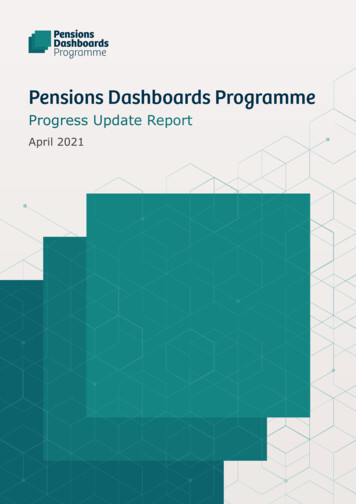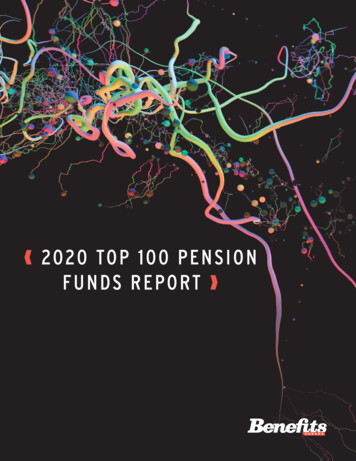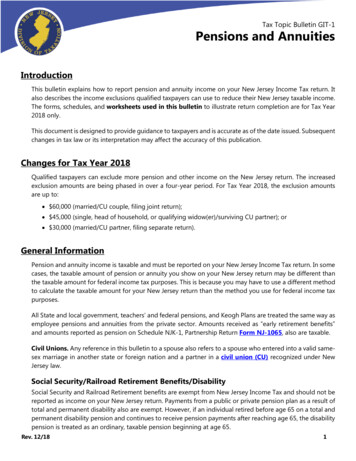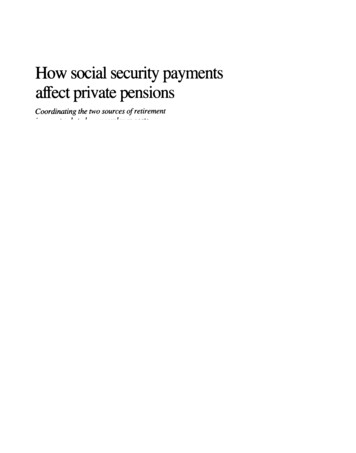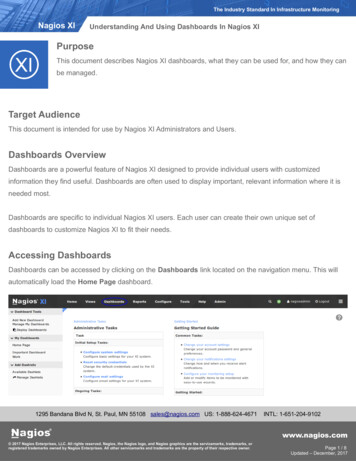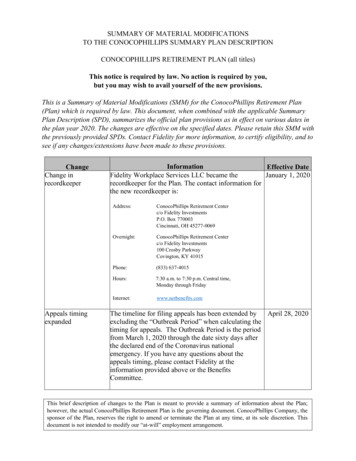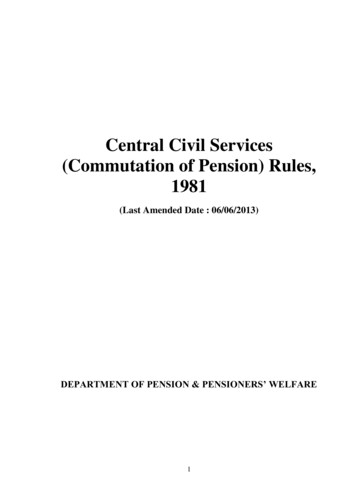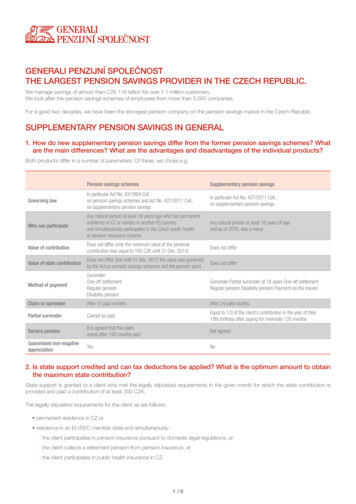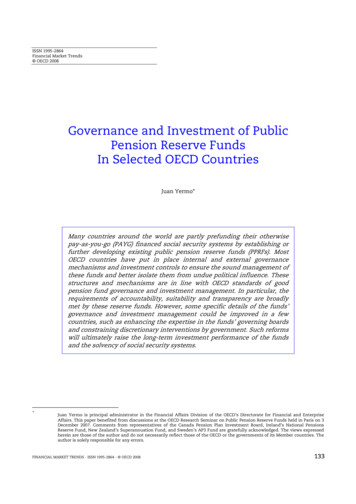
Transcription
Pensions DashboardsConsultationPENSION PROTECTION FUND RESPONSEFebruary 2019
Pensions Dashboards ConsultationPension Protection Fund responseAbout the PPFThe Pension Protection Fund (PPF) was established to pay compensation to members ofeligible defined benefit pension schemes, when there is a qualifying insolvency event inrelation to the employer and where there are insufficient assets in the pension scheme tocover PPF levels of compensation.The PPF is a statutory fund run by the Board of the PPF, a statutory corporationestablished under the provisions of the Pensions Act 2004. The PPF became operationalon 6 April 2005.On 10 July 2009 the Board of the PPF was also given the responsibility of being the schememanager for the Financial Assistance Scheme (FAS). FAS provides assistance to members ofeligible underfunded defined benefit schemes that started to wind-up between 1 January1997 and 5 April 2005, or between 6 April 2005 and 27 March 2014 where an employerinsolvency event occurred before 6 April 2005.General commentsThe Pension Protection Fund (PPF) welcomes the opportunity to respond to this consultationdocument.We are strongly supportive of the ambition underlying pensions dashboards, namely to enablepeople to better engage with their pension savings through digital channels.As an organisation with nearing 250,000 PPF members and c.155,000 FAS members, we haveourselves recently expanded our digital channels to better engage our members, and launchedan innovative new digital tool, ‘Retire Now’, which enables members to retire online withouthaving to call or write to us.We intend to participate with this important initiative and stand ready to constructively engagewith the proposed industry delivery group. Informed by our own customer service and deliveryexperience, we have sought to constructively contribute thoughts on how practically this mightbe most effectively realised, particularly in the areas of architecture, data protection andsecurity, governance and implementation.Questions for consultationWider benefits of a dashboardI. What are the potential costs and benefits of dashboards for:a) individuals or members?1
We agree with the conclusions in the consultation document regarding the benefits of pension’sdashboards for individuals.b) your business (or different elements within it)?It is difficult to identify or quantify the costs or benefits of dashboards to the PPF until we areclearer about how they would operate. As set out below, we think there are some key areas ofcost (revolving around system development to enable provision of data to dashboards andmanaging permissions to share data). However, further detail is needed to quantify this. Forexample, if PPF and FAS data delivery was based on data we already hold, in a structure that isnot complex and via a connection to a dashboard that is not too onerous, then we wouldn’texpect participation to be too costly. If we were required to build data to meet a dashboardstandard that was presented to individuals, that would increase our costs.Architecture, data and securityII. Do you agree with:a) our key findings on our proposed architectural elements; andb) our proposed architectural design principles?If not, please explain why.At a high level we consider the architectural design principles and the key findings to beappropriate. We do, however, want to highlight some implications of the proposed architecture.(This is from our own perspective but we believe the same considerations could well apply to DBschemes).Firstly, if we are to supply data direct to dashboards (rather than via an integrated serviceprovider) then we would need to establish a secure area, disconnected from PPF internalsystems where the appropriate data will be pushed and held (this is known as a “demilitarisedzone” or “DMZ”). The requirement for the DMZ is best practice to segregate external, nonbusiness access to PPF data and will ensure we comply with our security certifications and datacompliance responsibilities. For our part, we believe this is manageable but obviously has costand time implications.At this stage, we also believe that – in order to maintain compliance with data protectionlegislation – we would need to secure permission from our members to hold their data in theDMZ for the purposes of dashboard access and that we would need to update privacy noticesand / or contracts. The same would be true if we were to transfer data to an integrated serviceprovider. (The majority of the functions the PPF currently carry out are for “lawful processing - tocomply with a legal obligation”. The Pensions Act 2004 sets out our obligations and is the primaryreason why we need to process member data. Obviously this does not cover provision of datafor pension dashboards).This may require an up-front consent exercise whereas the consultation seems to envisage thatconsent would only be needed as an individual signs up to a dashboard (i.e. consent on an “ondemand” basis rather than in advance). Again, there are cost and time implications of this.2
Alternatively legislation could be amended to add dashboards to the list of acceptabledisclosures the PPF can make.Finally, the extent of our comfort with the proposed architecture will depend to a large extent onthe underlying detail.In particular, we support the consultation’s focus on correct identification of dashboardcustomers and welcome its reference to the National Cyber Security Centre’s Good PracticeGuide 45. However, this needs to be more specific to allow the PPF to have reassurance aroundthe quality of identification. Given the access to financial information, we would recommend atleast L2, and possibly L3 evidence on strength of identity before allowing dashboardparticipation. Further, an audit approach will be needed to ensure organisations maintain incompliance with these requirements to protect the ecosystem from issues with data protectionWe would also want to understand the governance and control of access to the DMZ, includinghow the connectivity to the data source will be encrypted and protected; and of course we wouldalso need clarity on what data will be required to be provided.Providing a complete pictureIII. Is a legislative framework that compels pension providers to participate the best way todeliver dashboards within a reasonable timeframe?IV. Do you agree that all Small Self-Administered Schemes (SSAS) and Executive Pension Plans(EPP) should be exempt from compulsion, although they should be allowed to participate on avoluntary basis?We agree that a high level of scheme participation is critical to the success of dashboards indelivering the objectives set out in chapter 2. Put simply, if information accessed via dashboardsis partial then it cannot help individuals fully understand their likely retirement income, and it islikely to damage take up. Given that, and the international evidence set out in chapter 5, wethink there is a case for compulsion.However, as the document highlights, the pension scheme universe is incredibly varied andcompulsion may be unreasonable for some segments (not just SSAS and EPP). In particular, weconsider that further detail on the costs of participation should be considered beforecompulsion is extended to all DB schemes. There will be fixed IT development costs in providingaccess to scheme data, the costs of using an integrated service provider (ISP) are as yetunknown, and there will also be costs associated with securing the necessary permissions fromscheme members and managing data in a DMZ or ISP on an ongoing basis. It is possible thatthose costs may be significant for small DB schemes (though of course many may be helped byusing a third party administrator).In addition, in making participation compulsory, it must be clear that sharing member data in theway required, the environment in which the data will be stored and transmitted etc, must complywith all necessary standards. Pension schemes must not be put in the position of beingcompelled to transfer scheme data without clear assurance that the data will be adequatelyprotected (in other words, pension schemes must not feel they have to choose between3
mandatory participation and being confident they are meeting their requirements under dataprotection legislation).V. Are there other categories of pension scheme that should be made exempt, and if so, why?If the PPF were to submit data to a dashboard, this would cover estimated PPF and FAS benefitsfor members who have transferred. For schemes in PPF assessment the situation is less clear asthese scheme are generally administered by our panel firms and members are subject to abenefit rectification when they transfer in to the PPF which could change their entitlement. Wetherefore suggest that schemes in the assessment period are either exempt from thedashboard, or a caveat is included explaining that these benefits could change.Implementing dashboardsVI. Our expectation is that schemes such as Master Trusts will be able to supply data from2019/20. Is this achievable? Are other scheme types in a position to supply data in thistimeframe?VII. Do you agree that 3-4 years from the introduction of the first public facing dashboards is areasonable timeframe for the majority of eligible schemes to be supplying their data todashboards?A period of 3 – 4 years seems a reasonable timeframe for eligible schemes to be supplying theirdata to dashboards, assuming this timescale starts from when the legislation comes into effect(as referred to in para 24).This timeframe will allow the PPF to create the necessary environments to allow for the data tobe accessed by the Pensions Dashboard. That said, the above answers on the security, transportencryption and opting in/out options on the dashboard, will be required in the first instance.Given wider IT transformation projects underway at the PPF, we believe a 2 – 3 year windowmight be a realistic timeframe for us to connect with the dashboard. As an interim step, we maybe able to provide the dashboard with a link to access the retirement modeller and benefitstatement viewer on the PPF and FAS member website.VIII. Are there certain types of information that should not be allowed to feature ondashboards in order to safeguard consumers? If so, why? Are there any other similar riskssurrounding information or functionality that should be taken account of by government?As previously mentioned, the PPF would not provide direct access to the original data andsource. Instead, a DMZ environment will be provided to host data that is required and has beenapproved by members.An authentication layer is critical to ensure that the right people are accessing very sensitivedata. If the appropriate 2 factor / one time authentication solutions are in place this shouldminimise concerns around security and the risk of data being accessed by the wrong people.Any data that potentially refers to information that the PPF cannot legally provide should not beavailable. This applies to any information that would be a breach of individual’s rights, or would4
be a regulatory / statutory offence (such as disclosure of restricted information under theprovisions of the Pensions Act 2004 .If the data is clear and standardised on the dashboard (appreciating that there will be quite a fewsteps to take place before this), there will also be requirements to make sure that the free adviceor guidance is appropriate and in line with the expectations of both FCA and TPR.IX. Do you agree with a phased approach to building the dashboard service including, forexample, that the project starts with a non-commercial dashboard and the service(information, functionality and multiple dashboards) is expanded over time?We believe this approach would be sensible. To start with a proof of concept could be built usinglow level sensitive information. A roadmap that shows enhancements and improvements wouldbe beneficial to consumers of the service. This would also allow us to monitor, audit and reportactivity and consumptions of data.X. Do you agree that there should be only one Pension Finder Service? If not, how would youdescribe an alternative approach, what would be the benefits and risks of this model and howwould any risks be mitigated?We agree with the proposition for only one Pension Finder Service – having a single solution forshould make set up easier for schemes. We would note, however, that this need not be apermanent requirement and as the service matures the case for introducing multiple pensionfinders could be reviewed. At the very least, care needs to be taken to ensure the serviceprovides value for money (e.g. through ensuring any intellectual property is centrally ownedtogether with any other elements in order for the provision of the service to be competitivelytendered, avoiding the situation where the whole system is dependent on one provider).Protecting the consumerXI. Our assumption is that information and functionality will be covered by existing regulation.Do you agree and if not, what are the additional activities that are not covered?As the pensions dashboard is likely to contain sensitive data (including personal data),safeguards are essential. Members will need to be clear about what they signing up to and whattheir information will be used for. For instance, information about whether governmentdepartments will be sharing the data (e.g. HMRC) will be necessary. It will also be helpful toconsider the benefits of the platform versus the risks of reliance e.g. if the data is incorrect andan individual relies on the dashboard information and subsequently receives differentpayments.The overlap between personal data and restricted information does not absolve the PPF of ourrestricted information obligations. We would need to comfortable with the gateway fordisclosure. As disclosure is not currently in accordance with our functions (which are narrowlyconstrued) we would have to find another route to disclose. The easiest way would be if thedashboards were to be put on the list of acceptable disclosures for the PPF. Alternatively wecould work within the existing legislation, but would need member consent, which is possible butmore complicated from a practical perspective.5
As mentioned earlier, we believe that schemes in assessment may need to be exempt fromfurther disclosure because at that point benefit outcomes are uncertain. Linked to this, we’veconsidered what the expectation might likely be on ongoing scheme trustees of PPF-eligibleschemes. It might be possible in the future to provide an estimated PPF compensation figure forongoing schemes, so that members can understand how their retirement options might changedepending on what happens to their employer in the future.If the dashboard is to be the most useful and include all sources of pension income, the PPF andFAS would need to be brought within the categories of scheme to disclose to it. As we’re not anoccupational pension scheme, it would be helpful to have the legislation tie together what ourobligations would be.Accessing dashboard servicesXII. Do people with protected characteristics, or any customers in vulnerable circumstances,have particular needs for accessing and using dashboard services that should be catered for?We assume that the dashboard accessibility will meet AA rating for web accessibility (or anequivalent). Ease of identity checking for scheme members to gain access to the dashboard willbe key. Other things you may like to consider are: Ease of changing the font, resolution, colour etc of the dashboard, if that can’t normallybe done via the individuals own PC/tabletUse of plain language (and also availability in other languages)Simple registration/log in process that doesn’t involve having to remember arbitrarypasswords or too much informationEasy to navigateOther help functionality, including information iconsAccess to webchat can be really helpful for someone who isn’t proficient in the use ofmodern technology and doesn’t like (or has circumstances that make it difficult tospeak) over the phone, but this would require resourcingGovernanceXIII. The department has proposed a governance structure which it believes will facilitateindustry to develop and deliver a dashboard. Do you agree with this approach? If not, what, ifanything, is missing or what workable alternative would you propose which meets theprinciples set out in this report?In principle, the suggested governance structure seems reasonable as it brings together theexpected parties to facilitate and develop the dashboard. It is important to clarify roles andresponsibilities of each group of key decision makers and prioritise the key elements that thegroup(s) will focus on. We note the review that has been undertaken of operating modelsoutside of the UK, and believe that it should be taken in to account when considering thecommercial/non-commercial dashboard approach to be followed. There also needs to becomplete clarity about ownership / responsibility of the proposed ecosystem/model. This isdependent on the data that has to be provided to support the dashboard and the method inwhich it is provided.6
We believe it would be best to have sign-in from all providers at an early stage as a mandatoryobligation and as referred to in the consultation agree with sharing best practice across othersectors such as Open Banking. Data standards, controls and mapping are key for the success ofthe initiative. This is dependent on the government stating what the standards are and aspreviously discussed, where possible implemented through legislation. The security frameworkand controls need to be set and governed centrally, and failure to comply should result inisolation or removal from the community as this places other organisations and individuals atrisk.Costs and fundingXIV. What is the fairest way of ensuring that those organisations who stand to gain most fromdashboard services pay and what is the best mechanism for achieving this?We think it appropriate that we would bear the cost of making our member data accessible todashboards (with the caveat that these costs must be proportionate). We are less clear on thecase for contributing to the wider set up costs (e.g. to establish the infrastructure and the firstnot for profit dashboard). Firstly, we would want to ensure that companies expecting acommercial benefit from the creation of the dashboards and associated infrastructure provide asuitable contribution. The approach to funding ought then to be considered once thecommercial framework is fully developed. Secondly, in terms of our own position, we are fundedby a levy on eligible defined benefit schemes. If we had to pay a levy or make a contribution tothe funding of the dashboard it is likely that the cost would need to be passed on to our levypaying schemes. As thinking on the approach to funding and the use of levies develops wewould welcome discussion regarding the PPF’s relatively unique position.XV. Do you have any other comments on the proposed delivery model and consumer offer?Paragraph 17 of the consultation document refers to the provision of impartial guidance. ThePPF could and should of course provide guidance from a PPF perspective for our data as many ofthe more generic references (ie references to freedoms/consumer choice) wouldn’t apply, butwe’d be interested to hear whether all schemes (or types of scheme) would be responsible forproviding their own guidance.Consideration should also be given to how queries raised or information required fromindividuals off the back of seeing their dashboards will be directed and handled.7
be accessed by the Pensions Dashboard. That said, the above answers on the security, transport encryption and opting in/out options on the dashboard, will be required in the first instance. Given wider IT transformation projects underway at the PPF, we believe a 2 - 3 year window might be a realistic timeframe for us to connect with the .
